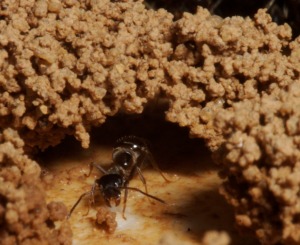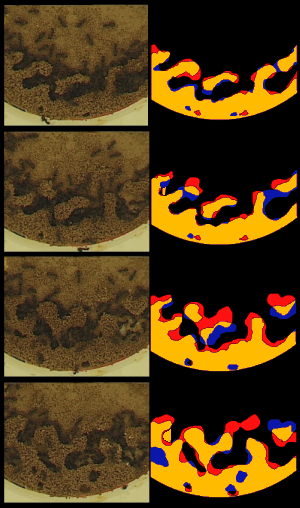Collective building behaviour by Lasius niger ants
A large part of my experimental research when at the CRCA in Toulouse focused on the study of mechanisms of building behaviour by the ant Lasius niger (mostly with Guy Theraulaz and Christian Jost).

An experimental model for the study of complex morphogenesis
An open problem in biology, but also in physics of nonlinear systems, is how do order and form rise in systems that had no previous spatial organization?
Mathematical models of morphogenesis (as those proposed e.g. by Lotka, Turing, Meinhardt, Murray and others) indicate that simple reactions between a small number of interacting molecules, or morphogens, can lead to the formation of complex spatio-temporal patterns. Yet, very little is known about which interactions among morphogens are actually at work in the formation of real biological structures. This is mostly due to the difficulty of following over time the interactions of several molecules in developing biological tissues.
The building behaviour of insect colonies is an example of how complex structures (the nests) emerge from simple interactions between the individuals, or between the individuals and the environment. Individual insects are unlikely to have a representation of the whole structure. Their behaviour can be understood as a sequence of responses to local stimuli.
Insect colonies are a good experimental system that can serve as a model also for other problems of complex morphogenesis. Because of their convenient size both the microscopic level of description (the individuals) and the macroscopic patterns (the nest, or the colony level behaviour) are easily accessible to the experimenter.
Statistical rules of individual behaviour
The behaviour of ants can be characterised at the microscopic level in terms of probabilities of performing a particular action, expressed as a function of the local configuration of the environment in the range of perception of the ant. For instance, one can estimate the probability to pick or to drop a pellet as a function of the roughness of the substrate, or the distance from an aggregate of nestmates and so on.

Modeling the formation of collective patterns

The microscopic rules directly estimated through the experiments are used to parametrize models that predict the growth of the global structure.
The modeling part is achieved mainly by Anaïs Khuong and Jacques Gautrais.
Measuring the form of the 3D structures
At a macroscopic level of description, the growth of the structure is evaluated by computing estimators of shape and size. The description obtained can then be compared with the output of the model, as a test for the parameters identified at the microscopic level.
The image shows snapshots of the ant construction at different times and a schematic representation of active fronts of building and excavation.

Related scientific publications
- Khuong et al. "Stigmergic construction and topochemical information shape ant nest architecture". PNAS (2016) [Web]